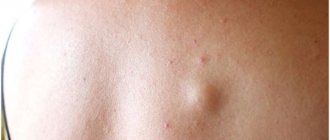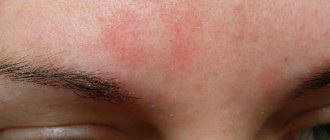Lipomas are benign tumors with the usual name wen. They appear on any part of the body except the palms and feet. Wen are usually painless, but cause aesthetic discomfort. Surgery will fix the problem, but is it necessary? Before thinking about surgical intervention, you need to find out why lipomas formed, whether it is worth removing them and how effective the procedure is.
Rice. 1. Lipomas should be removed promptly
Symptoms, signs, diagnosis of lipoma
Before you remove a wen, you need to make sure that it is exactly that. The shape of the wen formed under the skin is round or oval. It is mobile and soft to the touch; as a rule, no pain is felt when pressing on it.
Fatty deposits located under the skin of the face, neck, back, arms and other parts of the body usually do not cause any symptoms. A lipoma formed on internal organs causes the following symptoms:
- When a lipoma appears in the esophagus, coughing, nausea, and a feeling that there is a foreign body in the throat may occur;
- Chest pain may be the cause of lipoma formation in the mammary gland;
- Symptoms such as headaches, nausea, and vomiting may occur with a lipoma in the brain.
A lipoma is diagnosed visually during a clinical examination; if this is not enough, using ultrasound, x-rays, and computed tomography.
Surgical removal of lipoma
It would be more correct to call this procedure “traditional”, because any removal of tumors is a surgical procedure. Before the procedure, you will need to undergo an examination, the results of which will be needed by the surgeon. Most often, it will be enough to take a general blood and urine test and do fluorography. Depending on the general health of the patient, additional examinations may be required: blood sugar test, electrocardiogram, etc. - as prescribed by a specialist.
The operation itself on a small tumor is performed under local anesthesia. The surgical field is injected with anesthetic, disinfected, an incision is made through which the tumor is removed along with the capsule, and sutures are placed. The whole procedure takes no more than 15 minutes. The contents of the capsule are sent for histological examination, which is necessary to exclude a malignant process.[box#2]
If the operation is performed on open areas of the body - face, neck, arms - the surgeon may apply a cosmetic suture with an absorbable thread. In this case, there is no need to remove the stitches. Regular sutures are removed after 10-12 days, by which time the histology result is usually ready. If you are not prone to keloid scars, the scar will appear as a small light stripe that will become invisible over time.
Treatment of wen
Despite the fact that a wen under the skin usually does not cause any inconvenience, many people are interested in how to remove a lipoma . First of all, you should consult a doctor, especially in cases where inflammation of the wen has occurred. Those who are wondering how to squeeze out a wen should know that you should never do this yourself.
Removing wen at home can not only provoke infection into the wound, but also leave unsightly atrophic scars. However, in addition to the medical procedures that a doctor can offer, there are also traditional medicine and pharmaceutical preparations that will help cope with this problem.
Contraindications for surgery
Surgical removal of a lipoma, like any other surgical intervention, has a wide range of contraindications.
- Thus, surgical removal of wen is not performed on women in an “interesting” position, or during breastfeeding. Doctors recommend refusing surgery during “critical days.”
- Herpes, recent colds or infectious diseases are also reasons to undergo surgery.
- It is highly undesirable to perform surgical removal of a wen if the patient has been diagnosed with diabetes.
- Surgical removal is also fraught with complications due to secondary immunodeficiency - in other words, reduced body resistance.
How to remove wen using traditional methods
If it is not possible to visit a doctor’s office, you can try to remove the lipoma yourself. But this applies only to those formations that have appeared recently. If the lipoma is old, it needs to be treated only surgically.
Baked onion
Onions are considered one of the most effective means for removing wen. Do the procedure at least 2 times a day.
- Take one medium onion and bake in the oven.
- Grind the cooled onion using a meat grinder.
- Grate baby soap, add to onion and mix thoroughly.
- Apply the resulting mass as a compress to the wen.
Sour cream with honey
Before the procedure, you need to take a hot bath to steam the wen. Then the components of the prepared remedy for wen will better penetrate the adipose tissue of the tumor. Carry out the procedure every other day.
- Mix equal amounts of sour cream, honey and sea salt.
- Apply the resulting mixture to the problem area.
- After 20 minutes, rinse with warm water.
Why does lipoma develop?
Doctors cannot say exactly why the tumor develops. The true causes of the appearance of fatty tumors have not been established. However, there is a list of certain factors that provoke abnormal growth of fat cells.
- Genetics. More than half of patients with lipomas admitted that their blood relatives had a similar problem.
- Injuries. The development of a tumor can be provoked by bruises and other injuries to areas of the body with the greatest accumulation of adipose tissue.
- Disturbance of metabolic processes in the body.
Promotes the growth of wen:
- Liver diseases.
- Disorders of the pancreas.
- Malfunctions of the thyroid gland accompanied by hormone deficiency.
- Disturbances in the functioning of the pituitary gland.
- Blockage of the sebaceous glands.
- Bad habits, a lifestyle that is far from healthy, unhealthy diet, failure to comply with personal hygiene rules.
Treatment of lipomas with pharmaceutical products
Those who prefer to use pharmaceutical drugs should purchase Vishnevsky ointment. This product should be applied to an adhesive plaster and attached to the affected area, after 2 days the plaster should be replaced with a new one.
You can also use hydrogen peroxide. This drug should be regularly lubricated. After a few days, the skin on the affected area will burst and the contents of the wen will leak out.
lipoma treatment
Rehabilitation after removal
The duration of the recovery period directly depends on the number and size of the operated lipomas. It usually lasts several days and consists of protecting the postoperative wound from the penetration of pathogenic microorganisms into it. Therefore, the doctor will recommend that the patient not expose the site of the removed lipoma to sunlight and water for a week, and will also give recommendations on how to care for it.
Have you discovered a suspicious subcutaneous bulge in yourself or your loved ones? Experienced modern medical specialists are always ready to correctly diagnose the tumor and promptly offer you the most appropriate method to get rid of it, avoiding relapses and complications!
Services
Vaccination against tick-borne encephalitis
Kinesiology
Cardiologist appointment
ALL SERVICES
Useful articles
Let's say no to hair loss!
Luxurious smoothness of your skin
How a doctor can help you remove a wen
It is highly advisable that lipoma removal be performed by an experienced specialist. After a thorough examination, a dermatologist may prescribe the following procedures to remove wen:
- Mechanical cleaning. This method is considered the simplest. The procedure is carried out by piercing the wen with a needle, after which all its contents are removed. Sometimes the procedure is performed under local anesthesia.
- Removal of lipoma with laser . Laser therapy is considered the most progressive method for removing fatty tissue. The procedure is very quick and does not leave scars. In addition, the possibility of the wen reappearing in the same place is excluded.
Laser lipoma removal
Unfortunately, laser removal of tumors has its own contraindications. This method is not used during pregnancy and breastfeeding, diabetes, the presence of infectious skin disorders in the area of intended exposure, or immunodeficiency states. Deep-lying, large or branched neoplasms, as well as those whose structure includes vessels and nerves, are not removed using a laser.
In general, the operation is similar to the previous methods. The surgical field is anesthetized, the skin over the tumor is cut with a laser beam, and small vessels are cauterized at the same time. Then the capsule with its contents is removed using a clamp and cut off with a laser. At the end, the wound is sutured and a sterile bandage is applied. The entire procedure takes 15-40 minutes, and during the rehabilitation period you only need to follow the rules of asepsis to avoid inflammation of the wound.
Prevention of lipoma
After lipoma removal, the following preventive measures must be observed:
- reduce the consumption of fatty meats and high-fat dairy products;
- introduce vegetable oil and fish into the daily menu;
- refuse late dinners;
- move as much as possible.
You need to follow these recommendations not only if a lipoma has already appeared, but also if there is a hereditary predisposition. Doctors say that the risk group for the formation of wen includes middle-aged and elderly people.
What is lipoma
Lipoma is considered one of the most common types of benign neoplasms. It develops in the subcutaneous fatty tissue from fat cells, is painless to the touch and quite mobile, since it has a soft consistency, has a round shape with a smooth surface and fuzzy contours. As a rule, a lipoma is distinguished by relatively slow growth, usually ranging in diameter from 0.3 cm to 2-3 cm (in exceptional cases, its size can exceed 10 cm, and the neoplasm can have a compressive effect on the surrounding tissues).
The formation of lipomas is most often observed in women aged 35-50 years, although it can occur in people of both sexes and at any age. On the body, these neoplasms are located in places with a sufficient amount of adipose tissue (usually on the torso and limbs). Lipomas can be single or multiple.
Based on the type of tissue involved in the formation of the tumor, it is customary to distinguish the following types of lipomas:
- lipofibromas - consist exclusively of adipose tissue;
- fibrolipomas - consist of adipose and connective tissue;
- myolipomas - consist of adipose tissue with the inclusion of smooth muscle fibers;
- angiolipomas - consist of adipose tissue, including deformed blood vessels.
The factors that provoke the development of lipomas have not yet been sufficiently studied, but it is generally accepted that these tumors are formed due to:
- hereditary predisposition;
- injuries (in case of trauma to certain parts of the body, for example, legs or forearms);
- endocrine disorders;
- severe stress.
Diagnostics
As a rule, a wen is diagnosed during palpation during an examination by a specialist, and in most cases additional tests are not needed to remove the lipoma - the neoplasm is clearly visible. However, there are cases when the disease can be detected by chance. We are talking about breast lipoma, which can appear in women after menopause. As a rule, such a tumor is not dangerous, since it very rarely develops into cancer.
In addition, other ailments may resemble a wen, and then methods such as biopsy or ultrasound, MRI and radiography are prescribed. In the first case, the doctor will take part of the sample to check under a microscope. As for ultrasound, x-rays and MRG, this diagnostic method allows us to identify disorders in the internal organs.
Possible complications after surgery
It is also important to know what complications may occur after surgery. It is worth noting that this happens very rarely, for various reasons.
The most common complication is the presence of unaesthetic scars after surgery, which can be corrected by resorting to laser therapy. Due to improper care, the tissues at the surgical site may become inflamed if an infection occurs (including this that happens upon contact with tap water).
Signs of complications may include increased body temperature, swelling in the area where the wen is removed, and purulent discharge from the wound. In this case, you need to contact a specialist.
Prevention
There are no direct recommendations for preventing the appearance of lipomas, since their appearance does not depend on diet or lifestyle. The only method of prevention is regular monitoring (once every six months) of tumors (this is especially true for people who are genetically predisposed to the appearance of various types of tumors).
In addition, a wen may appear in another place after surgery, so you should carefully monitor changes in your body and consult a doctor in a timely manner.
Is lipoma dangerous?
Patients are often concerned about the extent to which the appearance of lipomas poses a danger to life and health. In most cases - this is important to remember - the neoplasm does not pose a danger, and the only thing that is required of the patient is to observe how it behaves.
Wen tumors are benign tumors primarily because they are not capable of metastasizing or spreading to other tissues. If they had retained this ability, they would have been transferred to the class of malignant tumors.
The greatest danger to humans is the risk of compression of adjacent tissues, which appears if the neoplasm is large. Most often, the nerves are compressed, which leads to unpleasant sensations and a person contacting a doctor.
However, most often patients have one complaint: the wen looks unaesthetic, which is why the question arises that it is necessary to get rid of it.
The risk that the tumor will become malignant is low. Patients are advised to monitor the tumor and sound the alarm if it begins to rapidly increase in size. It is progressive rapid growth that is the first symptom of malignancy, in which you should not waste time and immediately consult a doctor for additional diagnostics.
Vacuum aspiration – removal of lipomas without cuts and stitches – the most advanced technology
An effective high-tech method for removing both single and multiple subcutaneous lipomas.
After preliminary anesthesia, through a minimal puncture of 4-6 mm in an inconspicuous place, a special cannula is inserted into the lipomatous node through the subcutaneous tissue, through which the lipomatous tissue and its capsule are removed using vacuum aspiration.
The capsule is removed entirely, as it is tightly fused to the lipomatous tissue.
If there are several nodes nearby, then they are all removed through one puncture.
Immediately after removal, ultrasound monitoring is performed to monitor possible remaining elements of the lipoma.
And if such are detected, they are immediately removed.
The edges of the puncture do not require sutures, because its length is no more than 5-6 mm.
Therefore, the operation is completed by applying an aseptic sticker.
The last stage is elastic compression of the operation area - special compression hosiery is put on. This promotes better skin contraction (tightening), an immobilization effect is achieved, which accelerates recovery processes.
After 24-36 hours you need to change the bandage; you can do this at home yourself.
Rehabilitation
After surgery, the patient also needs rehabilitation. The doctor will tell you in detail about all the nuances in a leaflet with individual recommendations, which is given to the patient. General tips are:
- You can continue your normal lifestyle with only minor restrictions. So, it is necessary to care for the area of wen removal according to the recommendations of a specialist.
- It is necessary to treat the suture line and surrounding areas of the skin with an antiseptic and change sterile dressings every day.
- It is necessary to avoid traumatization and infection of the wound.
- It is effective to use sunscreens with SPF 30 or more if the area is exposed to ultraviolet radiation.
- After 7-10 days, in case of surgical removal of the tumor, you must come to remove the sutures. A control inspection will also be carried out here.
- Sometimes a histological examination is required; based on its results, the doctor prescribes individual recommendations for rehabilitation.
Complications
A complication of a lipoma should be considered torsion of the leg and disruption of the blood supply to the neoplasm, if we are talking about a lipoma on the leg. In this case, the node may undergo necrosis or ulcerate, which is accompanied by severe intoxication syndrome and can be life-threatening, so the tumor in this case must be immediately removed.
Another complication of lipoma should be considered its malignancy. Therefore, when active growth of the tumor begins, it is necessary to remove the tumor as quickly as possible and perform a tissue biopsy.









